
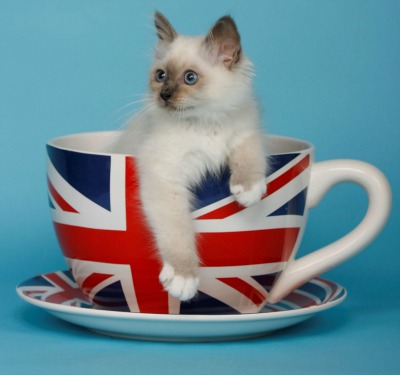 |
| Photo courtesy of Mick Bridge |
The story of the Birman in Britain began in 1965 when Mrs Elsie Fisher visited the Paris Cat Show, saw Birmans for the first time and fell in love with this fabulous breed. In partnership with her friend Mrs Margaret Richards she made swift arrangements to import one Seal point male and two Blue point females � the only colours then bred.
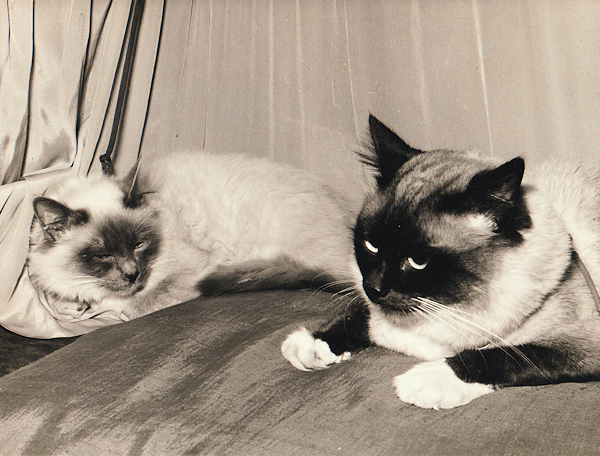
Nouky de Mon Reve, the Seal male (above), was born 17 September 1964 and transferred to Mrs Fisher on 21 November, arriving in this country shortly afterwards for his quarantine period. He was shown at the Herts & Middlesex show in September 1965 and then on exhibition at the National Show at Olympia in December. Orlamonde de Khlaramour and Osaka de Lugh were born in March and September 1965 respectively and arrived here a little later. It seems that new breeds did not have to wait to be granted Championship status at that time; the GCCF recognised the Birman breed in 1966 and Nouky and Osaka quite quickly became Champions. Nouky was a reportedly large cat with a superb coat but, in common with all the early Birmans, he had pale blue eye colour and an over-abundance of white on his front feet. Osaka was well-marked and had the best eye colour, but unfortunately was not a very good mother, with her kittens often reared by another queen, and she was also subject to fits; Orlamonde, on the other hand, although she lacked gauntlets, was a wonderful mother.
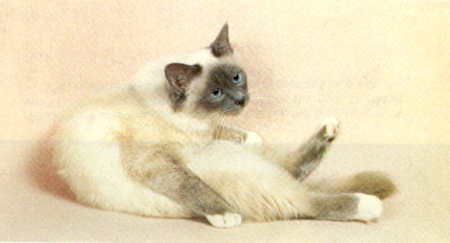 |
 |
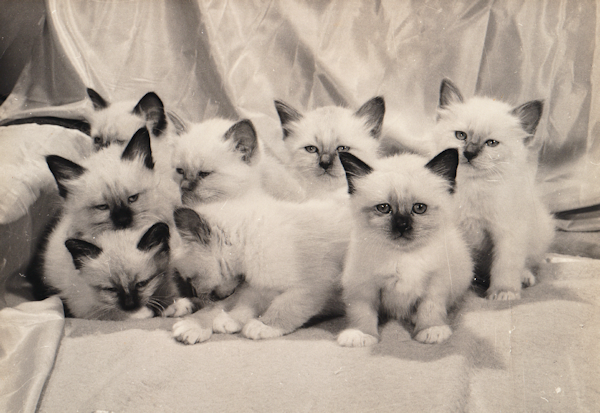 |
| Orlamonde de Khlaramour |
Osaka de Lugh |
First Birman kittens to be born in UK |
Nouky lived with Margaret Richards after his arrival and the two girls with Elsie Fisher, and they decided to breed them under the joint prefix of Paranjoti to found the breed in this country. Their first Birman litter of eight Seal and Blue kittens, from Orlamonde, was born on 3 July 1966 and they had wonderful names: Omar, Hercules, Singh, Khmer, Tristan (males), and Nefrettiti, Chimea and Isolde (females). Mrs Fisher kept Paranjoti Chimea and Mrs Richards kept Paranjoti Isolde who was the first Birman bred in England to produce kittens; she became a Champion and lived to an amazing 19� years of age.
With the birth of kittens a new stud was necessary and in 1966 the well-known judge Mrs Elizabeth Towe (later the first President of the Birman Cat Club) imported another Seal point male from France, Pipo du Clos Fleuri, handsome and beautifully marked, who also quickly became a Champion. He was very closely related to Osaka and Orlamonde through his father, Hamlet de Madalpour. Pipo spent the later years of his life with Mr Robert and Mrs Joyce Worth (Rojodanco), the first of our Birman breeder judges, and he died in 1979 at the age of 12 having sired many offspring.
 |
 |
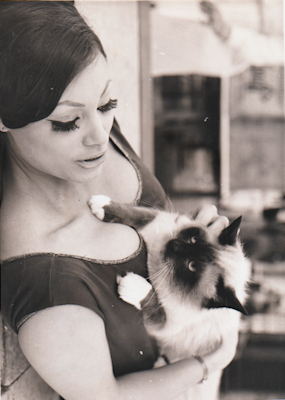 |
Pipo du Clos Fleuri |
Saturday September 11th 1965
This model is Carmen Dent and these photos were taken for the Daily Mirror & Sunday Mirror.
This cuddlesome creature, and we are talking about the cat, is thought to be the only puddy of it's kind in England, is one of a new breed called 'The Birman', known abroad as 'The Sacred Cat of Burma'. This cat is owned by two women in Hendon made it's first public appearance in a cat show at London's Alexander Palace
|
By 1967 the Paranjoti partnership of Elsie Fisher and Margaret Richards had disbanded and each reverted to their own original prefixes of Praha (Mrs Fisher) and Mei Hua (Mrs Richards). In 1968 Mrs Fisher brought in another male, this time a Blue point from Germany, Ch Ghandi von Assindia, a well marked cat with a beautiful coat but uncertain temperament on the show bench, and in 1970 Miss Betty Brown (Smokeyhill) imported Ch Solomon von Assindia, a Seal point of a different lineage and show temperament, although, again, both had Hamlet de Madalpour as an ancestor. These cats made an enormous impact on our breed through their many descendants. Later imports in the 1970s who appear on many pedigrees included Shani de la Valliere, a Seal female by Mrs Enid Holmes, Am Ch Rindy's Haven Zandra, a Blue point female of Smokeyhill parentage brought over from the United States by Betty Brown, and Badarene Blu Sinhtu, a Blue point male (and Nouky de mon Reve descendant) from Australia by Mrs Vivienne Creasey-Smith.
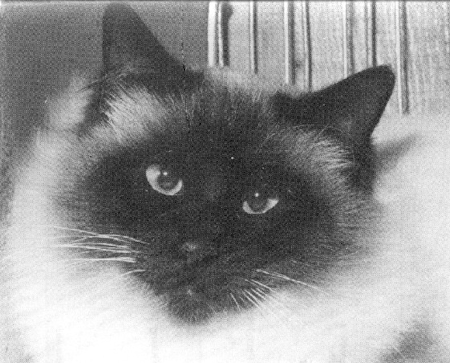 |
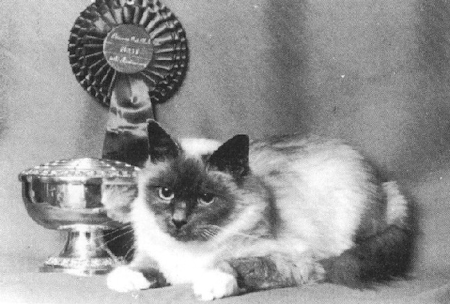 |
| Ch Solomon von Assindia |
Am Ch Rindy's Haven Zandra |
Elsie Fisher was by all accounts a colourful and eccentric personality of whom many stories are told, and a person of great determination in promoting the Birman. She was the prime mover in forming the Birman Cat Club, which convened it first meeting in January 1968 and was officially founded just a year later with herself as Chairman and Betty Brown as Secretary and Mrs Ursula Aggett as Treasurer. There were just seven members at the start but about 50 joined in the first year, of whom the first were Mr and Mrs Worth.
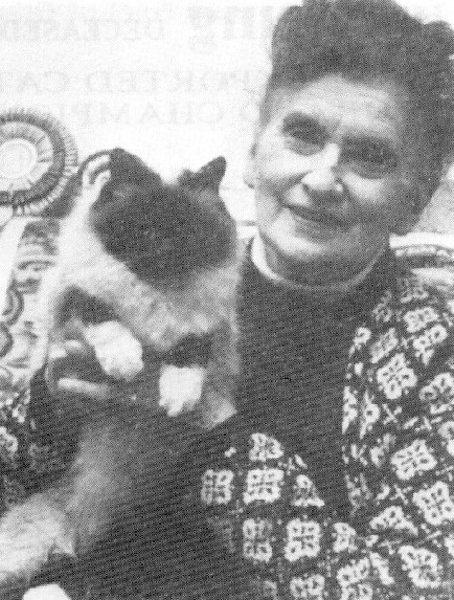 |
| Elsie Fisher |
It is extremely sad that Mrs Fisher did not live to see the Club's first Exemption show in 1979, as she died of cancer in 1977. This inaugural show was held at Chelsea Town Hall on 3 November, and the first Saturday in November remains the traditional date for the Club show to this day. It must have been a very memorable occasion: 212 cats had entered, nearly half of those in the Open classes, with 39 Pet Birmans, 59 Household Pets and 12 cats on exhibition. Overall Best in Show Exhibit was Verlam Afranius (later Champion), a Seal Male ho lived to the age of 18, owned and bred by Mrs Eileen Chalk.
Birmans on the show bench at that time were in the Longhair section, classed as Foreign Longhair along with the Turkish Vans. As the number of Birman breeders increased, more and more appeared at shows and there were Champions in plenty by 1978, when the GCCF granted Premier status to neuter cats. In that first show season three Birman neuter males gained Premier titles: Sagowa Mayo (owner Mrs Jan Beaumont, breeder Mrs Joyce Price), Smokeyhill Cheong Su (owner Mrs Katharine Freeman, breeder Miss Betty Brown) and Patrioona Caspar (owners Mr and Mrs Knight, breeder Mrs Pat Blair. In the large Grand and Miscellaneous classes Birmans were of course up against the then very dominant Persians and other Longhair breeds. The first Birman to become a Grand was Stratheden Saroki Chio (incidentally Best in Show Male Kitten at the first Birman Show) owned and bred by Mrs Teresa Cole, who achieved his Grand Premier title in August 1982. He was followed by the first Grand Champions, Tamandria Truffles owned and bred by Joyce Price and Belleview Francesca owned and bred by David Redtfeldt, who achieved their titles at the same show, the Suffolk and Norfolk in February 1983 where the atmosphere on the day was said to be electric. All these cats were Seal points.
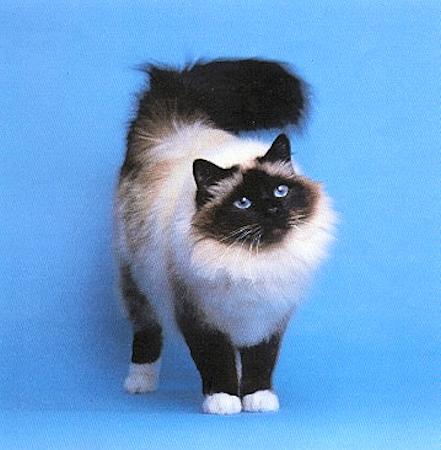 |
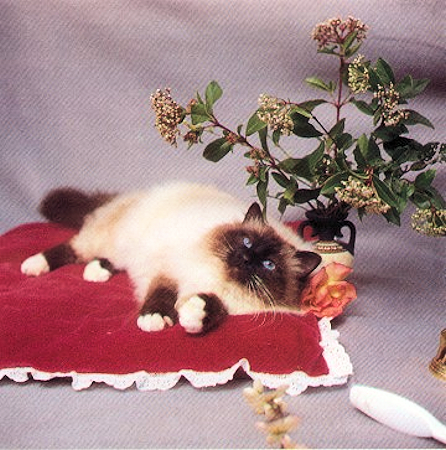 |
 |
| Stratheden Saroki Chio |
Tamandria Truffles |
Belleview Francesca |
Up to this time the only Birman colours being shown were still the original Seal and Blue points, but for the previous ten years a number of breeders had been working to develop the so-called "experimental" colours which are today firmly established, by mating Birmans with Persian Colourpoints, Siamese and some non-pedigree cats.
Mrs Elizabeth Brigliadori (Shwechinthe) and Mrs Shirley Wilson-Smith (Mandessa) were the first to begin breeding the Chocolate and Lilac points, in 1974, and Mrs Brigliadori writes in her article in Vivienne Smith's The Birman Cat Worldwide (published in 1991) that it took over 15 years, after many setbacks and disappointments, to fully develop these two colours and achieve the size and lovely Birman type and open expression.
The very first Red points were bred by Margaret Richards: Mei Hua Firefly and Mei Hua Firebird were born on 30 August 1975 and Firefly was among the cats on exhibition at the first Birman Show. The Red Series breeding programme was then taken over and expanded by Hilary and Ken Clarke (Hilken) and their Hilken Red Hercules appeared on exhibition at the 1982 Birman Show, followed by three of his Red and Tortie-point progeny and also Hilken Red Arrival at the 1983 show.
Tabby points were first developed by Mrs Pam Healey (Sibir) and Shirley and Chris Stanton (Julipaul), and the first seen in public were brother and sister Blue Tabby points Julipaul Enrico and Esmeralda who were on exhibition at the Club's first Championship show in 1984.
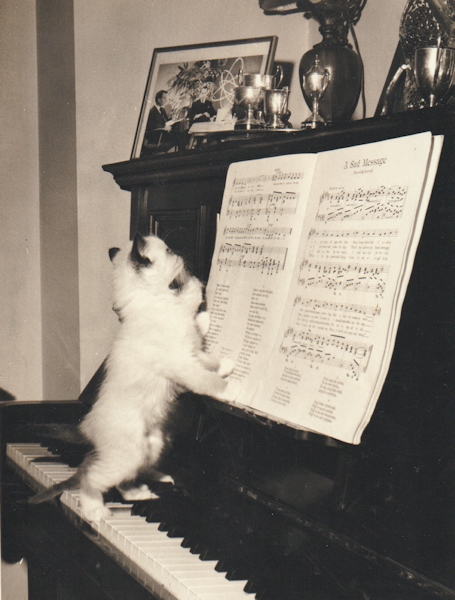 |
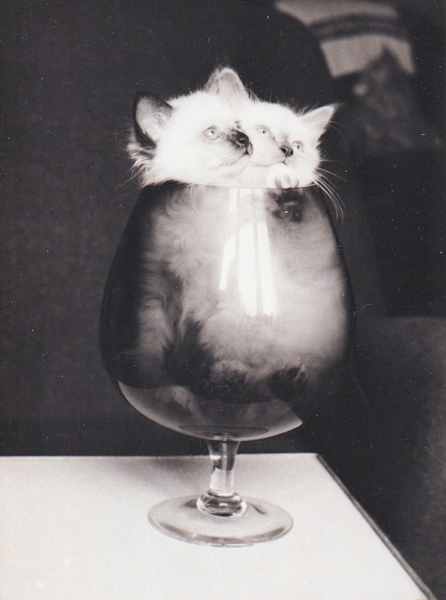 |
The GCCF having granted competition to the experimental Birman breeds for Merit
Certificates in Assessment classes in1983/84, the 1984 Birman Show was a significant landmark for another reason as it was the first year of these classes. Five Hilken Red points entered on this occasion, but the following year there were also Chocolates, Lilacs and Blue Tabbies. Numbers increased year on year, with more breeders venturing into the new colours, culminating in the 1991 Birman show at Leamington Spa when an impressive total of 50 cats and kittens had entered the Assessment classes.
1992 was the next important stage for the new colours: the Intermediate certificates, and an even more impressive total of nearly 70 Adults, Kittens and Neuters entered the classes at that year's Birman Show, with the colours split into Chocolate & Lilac, Red, Cream & Tortie, and Tabby points, as at present.
Two years later, in June 1994, the great achievement for the new colours � Champion status at last. Three cats gained titles at the first possible show, the Maidstone & Medway on 16 July: Ch Addeilo Crystalromance (Blue Tortie Tabby owned by Mrs Julie Keith and bred by Miss D Lewis); Pr Shwechinthe Nuqui (Chocolate male owned and bred by Mrs Elizabeth Brigliadori and her daughter Dr Kathryn Robson); and Pr Klassyklogs Red Duke (Red male bred by Mrs Jane Tackley and owned at that time by her daughter and son-in-law Rachel and Nick Riordan).
At the Birman Show in November in Stockport (the first Birman Show in the North), there were 9 Adults and 4 Neuters who had gained their titles in the Summer and were entered in the new AOC (Any Other Colour) Grand classes. Among these were Mrs Brigliadori and Dr Robson's Ch Shwewchinthe Zarib (Lilac male), Ch Shwechinthe Zunetra (Chocolate female) and Pr Shwechinthe Nuqui; Ch Keitum Krackerjack (Seal Tabby male owned and bred by Mrs Julie Keith); Ch Shandatal Hillbilly Blue (Blue Tabby male owned by Mr & Mrs Merrett and bred by Mrs Shirley Talboys; and Pr Addeilo Samsora (Lilac female neuter bred by Mrs Brigliadori and jointly owned with her daughter).
Krackerjack, a Grand winner on the day and Best in Show Adult, had actually already attained his Grand Champion title three weeks earlier, the very first of the new colours to do so. Hillbilly Blue followed suit just a few months later as the first Blue Tabby Grand, while Zarib, Zunetra, Nuqui and Samsora also went on to be the first of their Adult & Neuter colours to become Grands early the following year (Samsora the first AOC female neuter) � a fitting achievement by Shwechinthe for the dedicated years of development. It should also be recorded here that a certain Klassyklogs Krafty Karess (Seal Tortie owned and bred by Mrs Jane Tackley) not yet a Champion, was Best in Show Female Adult at the show and the following Spring was the first AOC female to become a Grand Champion.
However, backtracking a little, 1992 had brought a huge change to the show scene for Birmans and other breeds � the creation, after years of campaigning, of the Semi Longhair section. At this stage only Birmans and Turkish Vans had Championship status and so Grand classes were at first rather small compared with the previous daunting competition of the Longhair Section. As the Somali and plentiful Maine Coon, Norwegian Forest and Ragdoll breeds graduated to this level, as well as our own AOC Birmans, the size of the Grand classes increased to equally competitive numbers, until Birmans were finally given their own Grand classes at all-breed shows from June 2003. 1992 was also the year of the official splitting of neuters into Male and Female in the Open classes at all Championship shows (the Birman Show had been doing so from 1986), at last giving realistic opportunities for our Birman ladies to become Premiers!
Backtracking again, the Birman Breed Advisory Committee was formed in 1982 with the principal function of recommending to the GCCF changes in the Standard of Points and the appointment and monitoring of Birman judges for ratification by the GCCF. Its members consisted of the members of the Birman Cat Club Committee, but this changed after the formation of the other three Birman breed clubs: the Northern Birman in 1995, and the Seal & Blue Point and the Southern & South Western in 1999. Once these clubs had become
members of the GCCF the BAC consisted of an equal number of delegates from each club.
The GCCF publishes on its website an Analysis of Breeds Registered by year dating back to 1988, covering more than 30 recognised breeds. The Birman is among the most popular breeds in Britain , having held a consistent position of 5th or 6th place (current) in the listings, with an average figure of 2100 kittens per year registered during this time � quite an achievement from the small beginnings with the three first imports in the mid-1960s.
Janet Osborn
(Editor, Birman Cat Club Magazine)
June 2006
Copyright � Janet Osborn 2006
Sources
The Birman Cat by Vivienne Smith (Creasey)
The Birman Cat Worldwide by Vivienne Smith
The History of the Birman Cat Club 1969-1999 by Betty Brown (Birman Magazine article 1999)
A Tribute to Seal & Blue Birmans compiled by Anne Madden (Birman Magazine article 2000)
Show catalogues
Birman Year Books
Cats Winners Congratulations adverts
|


